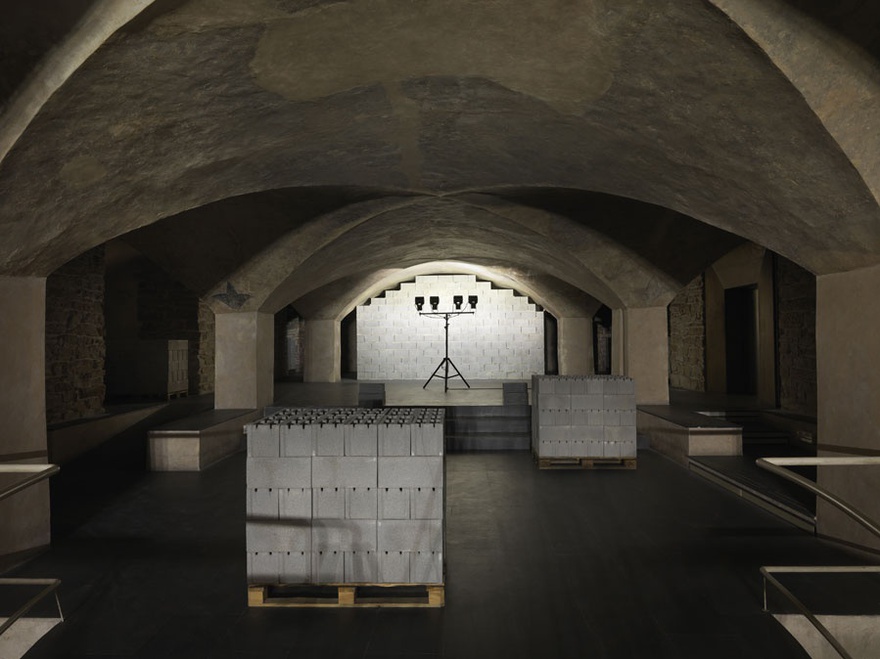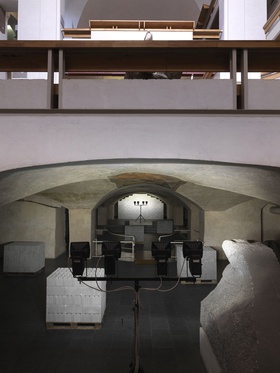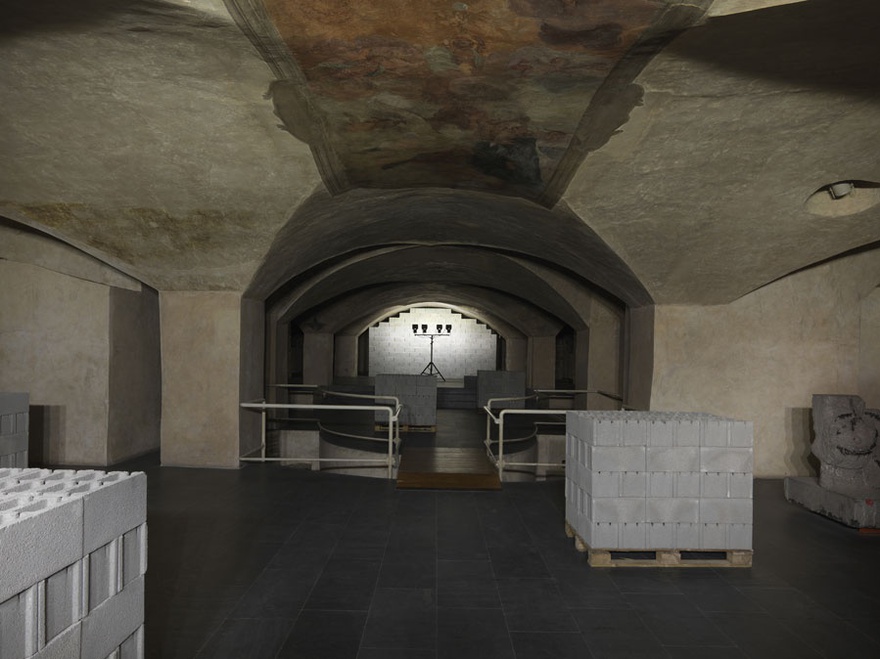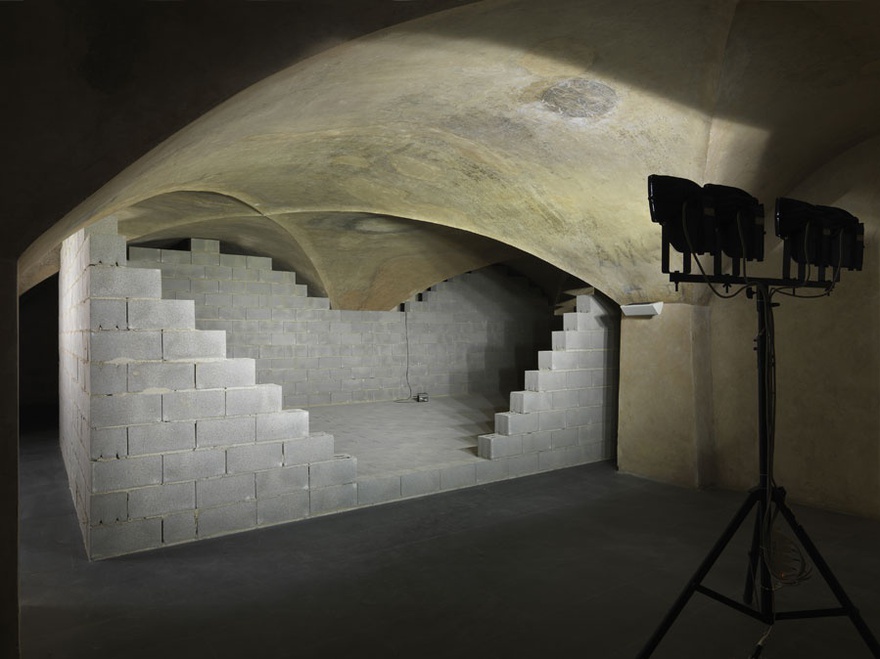Reviews
La Mano de Dios
Rayyane Tabet at Museo Marino Marini
A loud voice escalates into shouts against the backdrop of the swelling noise of what seems to be a cheering mass. Its texture is scratchy and full of emotions. I slowly distinguish its words:
The ball goes to Maradona.... still Maradona...He could pass it to Enrique... again Maradona, now dribbling...he goes on, he goes on past three players... still Diego... brilliant, brilliant!
Touches it for Valdano! Maradona goes on... he jumps in front of Shilton, he heads…..handball!
Goooal! Goooooooal! Goooooooal! Goooooooal!![1]
This is the voice of Uruguayan journalist Víctor Hugo Morales picking up speed while reporting live for Spanish-speaking countries on the 1986 soccer World Championship quarter-final in Mexico City between Argentina and England. A game that would enter the eternal Valhalla of sports history for the irregular 1:0 goal that Diego Armando Maradona scored in the 51st minute with the help of his left hand, and which came to be known as La Mano de Dios.[2] Spurred by this magic goal, the Argentinian team won the game and ultimately the championship. The match was filled with political tensions due to the open wound of the Falklands war, which had occurred only four years earlier: a turf battle between two nations claiming control over the Falkland Islands. In essence, the game's importance far transcended the concerns of the soccer pitch; instead, it came to embody the revenge against Europe and its colonial empires and the making of Maradona as a global hero.
I hear Morales' frenetic joy while walking down the stairs that lead to the crypt of the Museo Marino Marini in Florence. Here, exactly 30 years later, Lebanese artist Rayyane Tabet picks up this legendary streak of history and weaves it into a larger network of narrative associations for his solo show emblematically titled La Mano de Dios, curated by Leonardo Bigazzi. The show concludes a series the artist has been forming over a period of ten years: Five Distant Memories: The Suitcase, The Room, The Toys, The Boat and Maradona (2006–2016). This is a dense and versatile body of work that takes five early childhood impressions as points of departure for a complex set of scenarios that merge historical facts with personal memories. Five works constitute the backbone of this series, whose references have grown, both in number and complexity, throughout the years. A packed suitcase to be used in case of emergency (Fossils, 2006); the record of a bedroom in a dream (1989, 2012); thousands of block toys (Architecture Lessons, 2013); an old boat used by his family in a failed attempt to move out of Lebanon (Cyprus, 2015); and lastly, a goal scored by Maradona.
To fully appreciate Tabet's works means to unravel the nature of their components, and their conscious and accidental entanglements. Because Tabet is a storyteller who plays with facts, anecdotes stories, and myths (read: material that is not documented nor fact-checked), objects and materials that retain layered and highly evocative meanings consciously play with the growing readings that become sediment in their form as they move through time and space.[3]
In La Mano de Dios, the evocative fragment of Morales' commentary is followed by the loud sound of a siren that, as the wall-text explains, was played on the other side of the planet by radio host Charif Al Akhawi to celebrate the win on Radio Liban Beirut. This siren was usually used to warn of heavy bombings in the city – a globally recognizable sign of a coming threat and a call for collective action. These two historical records come together in an aural composition pervading the museum in a three-minute loop followed by a long silence. It is played on a radio that, from its appearance, could have been manufactured in the 1980s. Whether you care for soccer or not, and whether you have experienced moments of war and life threatening danger, almost anyone's ear is sufficiently familiar with these sounds for them to have immediate effect on the psyche. The combination prompts an uncanny and rather sinister feeling, strengthened by the fact that the exhibition takes place in the crypt of the museum allegedly used as a shelter during World War II. The building, symptomatic of a very Italian type of institution, is a palimpsest of different historical periods and its uses. Built as a religious settlement in early Christianity and renovated during the 1400s under the guidance of Leon Battista Alberti, himself the epitome of the Florentine Renaissance, though it lost its function in 1808 when Napoleon disallowed ecclesiastic orders. It then became the headquarters of the city's lottery, a district court, a tobacco manufactory, and a military depot. Finally in 1988, with the architectural remodelling of Lorenzo Papi and Bruno Sacchi, the building became a museum with a wide collection of works by Marino Marini, a key representative of Italian art of the twentieth century, whose work is mostly known for figurative and often monumental sculptures revolving around the figure of the knight.
As in many of Tabet's artistic ventures, the history and architectural features of the building matter. His previous training as an architect at Cooper Union in New York clearly had a major influence on his interventions, characterized by a highly staged and minutely orchestrated structure responding to the space in which they occur. Even more so in this exhibition, for which the artist inserted a bunker-like environment made out of low-cost concrete masonry bricks into one of the crypt's vaults. While I am inclined to think that this architecture's dimension might be related to the artist's past (which includes memories of the Lebanese civil war), I discover that it is instead an aesthetic choice: an attempt to insert a 5x10x3 metre volume into the volume of the crypt, following a purely subjective sense of harmony. This gives to the work an additional complex substance, somewhat twisting and almost sarcastically commenting on the principles of the Florentine renaissance, its influences still overwhelmingly dominant in the architecture and generally in the cultural programs of the city. If we think of Renaissance's perspective and principles as manmade aesthetic conventions that have been so dominant and perduring to become understood as natural and innate, than Tabet's intervention could be read as an intelligent metaphor of the very human motives and power structures on which this protocol was based.
The brick structure is not alone in the space. Tabet yielded all the leftovers into minimal, almost cubic sculptures on pallets that respond to the parallel presence of three big rather sketchy and abstract sculptures in stone, dating back to the early seventies by Marino Marini's, whose artworks share the exhibition space of the crypt. Characteristic of Marini's post-war work, the historical and material weight of these sculptures is underscored by the succinct and minimal presence of Tabet's raw concrete interventions, which share the space. The crypt is illuminated with disproportionally large and bright spotlights whose illumination recalls the light given off in construction sites and stadiums – blatant, strong, and cold. The lights carve out every detail on the materials' surface, and unveil hidden fresco fragments on the crypt's ceiling, thus highlighting the multiple layers of history buried in the strata of the exhibition space itself.
The equilibrium that emerges the spatial experience of such an entanglement of narrative threads is contingent on the individual spectator. While this might be true about art in general, interpretative openness is a very conscious condition created by the artist through his work. It is a creative decision that manifests in the utter lack of interpretative notes in all press releases, curatorial, wall or exhibition texts related to the project. The intention, it seems, is to ultimately encourage a form of understanding through a constant state of flux, in the production of an exhibition that is largely dependent on personal acts of imagination that look backwards to turn forward. In working with the museum's space, and thus in interacting with its history alongside his own, Tabet provides just enough to let collective history and individual memory enter into a shared space where relative and partial readings exist and intermingle.
Rayyane Tabet, La Mano de Dios, curated by Leonardo Bigazzi, was on show at Museo Marino Marini between 9 June 9 and 31 July 2016.
[1] My own English translation from Spanish of Víctor Hugo Morales, YouTube, ed. 9 May 2008. 'Maradona gol mano de Dios – hand of god – victor hugo'.
[2] 'The hand of God' in Spanish.
[3] I am inspired here by Theodor Adorno's writings on the relation between a form and the content that sediments in it in relation to the social, political, cultural conditions that determine both its making and its reading through time, and how its growing meanings are part and parcel of its present texture. For more, check: Theodor W. Adorno 'Art, Society, Aesthetics', in Aesthetic Theory (1970), ed. by Gretel Adorno and Rolf Tiedemann, trans. by Robert Hullot-Kentor (London: Continuum, 1997).


















